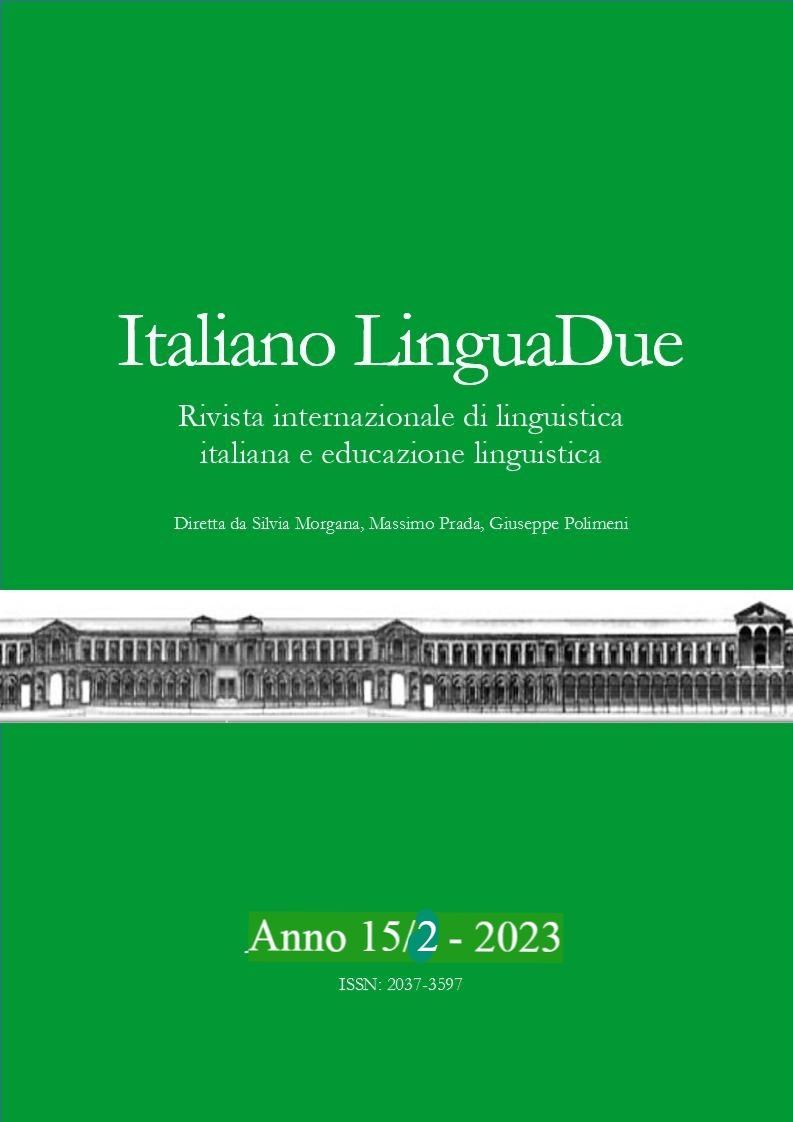“NON SIAMO QUESTE ESPERTE”. USI VALUTATIVI DEI DEITTICI PROSSIMALI E DISTALI
DOI:
https://doi.org/10.54103/2037-3597/22014Abstract
In questo contributo si indagano alcuni tipi di costruzioni dell’italiano in cui i deittici prossimali e distali, a partire dalle funzioni originarie, hanno sviluppato delle ulteriori funzionalità pragmatico-discorsive. In particolare, i dimostrativi questo e quello all’interno di alcune specifiche configurazioni sintattico-discorsive possono assumere funzione valutativa e intensificare o mitigare gli attributi qualitativi del referente, facendo leva su conoscenze realmente condivise dai parlanti o presupposte come tali. Tramite l’analisi di dati autentici estratti dal webcorpus itTenTen20 e adottando un approccio misto (corpus-driven e corpus-based), ci proponiamo di descrivere i processi inferenziali che permettono all’interlocutore di attivare la lettura valutativa dei deittici in due particolari costruzioni: [quel N lì] e [(N1) non è (che sia) questo N2].
“We are not these experts”. Evaluative uses of proximal and distal deictics
In this contribution, we intend to investigate two Italian constructions in which proximal and distal deictics, starting from their original functions, have developed additional discursive-pragmatic functions. In particular, the demonstratives questo ‘this’ and quello ‘that’ within some specific syntactic and discursive configurations can take on evaluative functions. They can intensify or mitigate the qualitative attributes of the referent, drawing on the knowledge shared by the speakers or presupposed as such. Through the analysis of authentic data from the itTenTen20 webcorpus and adopting a mixed approach (both corpus-driven and corpus-based), we aim to describe the inferential processes that enable the interlocutor to activate the evaluative reading of deictics in two specific constructions: [quel N lì] and [(N1) non è (che sia) questo N2].
Riferimenti bibliografici
Ariel M. (1998), “The linguistic status of the here and now”, in Cognitive Linguistics, 9, 3, pp. 189-238.
Benigni V. (2018), “Ad hoc categorization in Russian and multifunctional general extenders”, in Folia Linguistica, 52, s39-s1, pp. 97-123.
Benigni V., Latos A. (2023), “Una montagna di errori: costruzioni binominali con classificatori metaforici in italiano, polacco e russo”, in Studia universitatis hereditati znanstvena revija za raziskave in teorijo kulturne dediščine, 11, 1, pp. 11-31.
Chilton P. (2014), Language, Space and Mind: The Conceptual Geometry of Linguistic Meaning, Cambridge University Press, Cambridge.
Delahunty G. P. (1995), “The inferential construction”, in Pragmatics, 5, 3, pp. 341-364.
Delahunty G. P., Gatzkiewicz L. (2000), “On the Spanish inferential construction ser que”, in Pragmatics, 10, 3, pp. 301-322.
Delahunty G.P. (2001), “Discourse functions of inferential sentences”, in Linguistics, 39, 3, pp. 517-546.
Diewald G. (2011), “Pragmaticalization (defined) as grammaticalization of discourse functions”, in Linguistics, 49, 2, pp. 365-390.
Divjak D. (2019), Frequency in Language: Memory, Attention and Learning, Cambridge University Press, Cambridge.
Dryer M. S. (1996), “Focus, pragmatic presupposition, and activated propositions”, in Journal of Pragmatics, 26, 4, pp. 475-523.
Fox B. A. (1996), Studies in Anaphora (Vol. 33), John Benjamins Publishing Company, Amsterdam.
Goldberg A. E (1995), Constructions: A construction grammar approach to argument structure, University of Chicago Press, Chicago.
Goldberg A. E. (2006), Constructions at work: The nature of generalization in language, Oxford University Press, Oxford.
König E. (2020), “Beyond exophoric and endophoric uses: Additional discourse functions of demonstratives”, in Næss Å., Margetts A., Treis Y. (eds.), Demonstratives in discourse, Language Science Press, Berlin, pp. 21-40.
Heine B. (2002), “On the role of context in grammaticalization”, in Wischer I., Diewald G. (eds.), Typological Studies in Language, John Benjamins Publishing Company, Amsterdam, pp. 83-101.
Lacroce A. (2023), Linguistic classification and its mechanisms: The case of binominal constructions in non-classifier languages, Ph.D. Thesis, Università degli Studi Roma Tre - Sapienza Università di Roma, Roma.
Langacker R. W. (1991), “A usage-based model”, in Id., Concept, Image, and Symbol. The Cognitive Basis of Grammar, Mouton De Gruyter, Berlin, pp. 261-288.
Langacker R. W. (2008), Cognitive grammar: A basic introduction, Oxford University Press, New York.
Lakoff R. (1974), “Remarks on this and that”, in Proceedings of the Tenth Regional Meeting of the Chicago Linguistic Society, 10, pp. 345-356.
Levinson S. C. (2006), “Deixis”, in Horn L. R., Ward G. (eds.), The Handbook of Pragmatics, Blackwell Publishing Ltd, Oxford, pp. 97-121.
Lyons J. (1977), Semantics, Cambridge University Press, Cambridge.
Masini F. (2016), Grammatica delle Costruzioni, Carocci, Roma.
Pusch C. D. (2006), “Marqueurs discursifs et subordination syntaxique, La construction inférentielle en français et dans dautres langues romanes”, in Drescher M., Frank-Job B. (eds.), Les marqueurs discursifs dans les langues romanes, approches théoriques et méthodologiques. Romanistentag, Peter Lang, New York, pp. 173-188.
Rybarczyk M. (2015), Demonstratives and possessives with attitude: An intersubjectively-oriented empirical study, John Benjamins Publishing Company, Amsterdam.
Stalnaker R. (2002), “Common ground”, in Linguistics and Philosophy, 25, 5/6, pp. 701-721.
Wierzbicka A. (1986), “What’s in a noun? (or: How do nouns differ in meaning from adjectives?)”, in Studies in Language. International Journal sponsored by the “Foundations of Language”, 10, 2, pp. 353-389.
Zhang X. (2017), English Quasi-Numeral Classifiers. A Corpus-Based Cognitive-Typological study, Peter Lang, Bern.
Zanchi C. (2018), “On the Italian demonstratives with attitude: A cognitive intersubjective account”, in Archivio Glottologico Italiano, 103, 1, pp. 98-128.
Dowloads
Pubblicato
Fascicolo
Sezione
Licenza

Questo lavoro è fornito con la licenza Creative Commons Attribuzione - Condividi allo stesso modo 4.0.




